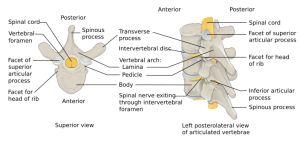Blunt neck trauma
Revision as of 08:42, 27 January 2015 by Rossdonaldson1 (talk | contribs)
Background
- Suspect vascular damage to cord if discrepancy between neuro deficit and level of spinal column injury
- Cord injury is more likely if anterior (vertebral bodies) AND posterior (spinal canal) columns are disrupted
Differential Diagnosis
Vertebral fractures and dislocations types
- Cervical fractures and dislocations
- Thoracic and lumbar fractures and dislocations
Spinal cord trauma
Vertebral and Carotid Artery Dissection
Workup
Fracture
NEXUS Cervical Spine Rule
Radiography is not necessary if the patient satisfies ALL of the following low risk criteria:
- No midline cervical tenderness
- No focal neuro deficits
- Normal alertness
- No intoxication
- No painful distracting injury
C-spine imaging should be considered unless the patient meets all of the above low risk criteria[1] [2]
^If find injury consider CT C-spine, x-ray rest of spine
Spinal cord trauma
- Neuro exam
[Vertebral and Carotid Artery Dissection]]
Management
- Prehospital
- Hospital
- See specific diagnosis
See Also
Source
- National Spinal Cord Injury Statistical Center (NSCISC). Spinal Cord Injury. Facts and Figures at a Glance. Birmingham, Ala: NSCISC; July 1996
- Ivy ME, Cohn SM. Addressing the myths of cervical spine injury management. Am J Emerg Med. Oct 1997;15(6):591-5
- Woodring JH, Lee C, Duncan V. Transverse process fractures of the cervical vertebrae: are they insignificant? J Trauma. June 1993; 34(6):797-802.
- Tintinalli's





